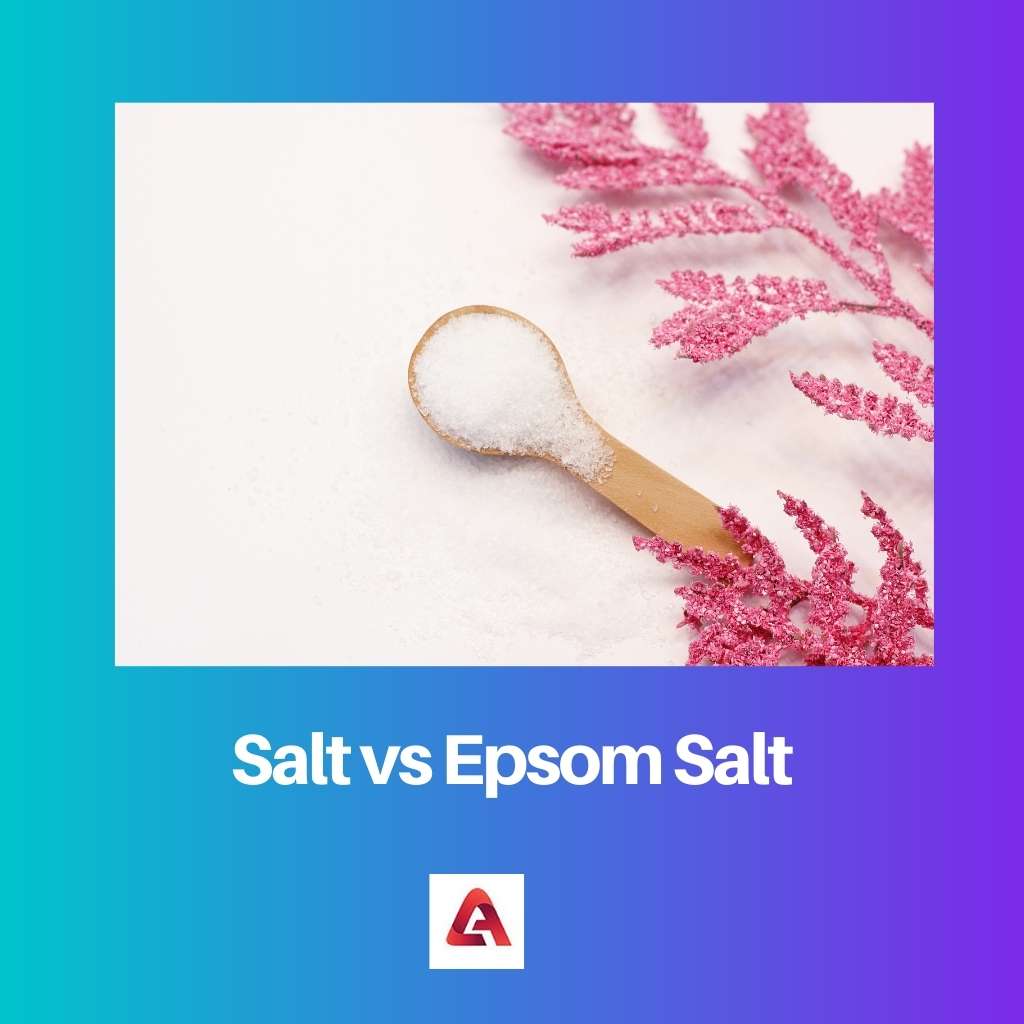Salts is a term we use in our day-to-day life. The most common type of salt we know is table salt which is also known as sea salt.
But there are numerous types of a wide range of salts used for different purposes. Epsom salt is one of them, which we may have heard of in recent times.
Salts are natural products derived from saltwater regions or minerals from different places of the earth. When it comes to the application of salts, the normal sea salt and Epsom salt are the most popular ones and have great demand all over the world.
Key Takeaways
- Table salt primarily comprises sodium chloride, while Epsom salt contains magnesium sulfate.
- Epsom salt has various health benefits, such as relieving sore muscles and promoting relaxation, whereas table salt serves primarily as a seasoning and preservative.
- Table salt dissolves quickly in water, while Epsom salt takes longer and is used in baths for therapeutic purposes.
Salt vs Epsom Salt
Salt, known as table salt or sodium chloride, is a popular cooking ingredient and preservative. Epsom salt is a magnesium and sulfate mineral combination, it is more extensively utilized for its therapeutic effects and is frequently added to baths to relax muscles and relieve discomfort.

Salts are used in various fields. The main purpose served by common sea salt is to add a salty taste to food. It is easily available at grocery stores.
Salt, which contains Sodium Chloride, also balances the ratio of the electrolyte in our body. It is an important raw material for various chemical compounds preparation like caustic soda, bathing soap, sodium hydroxide, etc.
Epsom Salt is largely used for healing and soothing purposes. The salts are derived from natural products and carry significance for remedies for pains and ailments.
This salt was first discovered in the city of Epsom, which is present in Surry, England. It also heals stress and soreness in our muscles.
Comparison Table
| Parameters of Comparison | Salt | Epsom Salt |
|---|---|---|
| Origin | First found in China | First found in Surry, England |
| Chemical Composition | Contains Sodium Chloride | Contains Magnesium and Sulfates |
| Structure | A hygroscopic adsorbent crystalline structure | Resilient structure |
| Uses | In preparation of food and manufacturing of chemical compounds like Caustic Soda, Sodium Hydroxide, Soaps, etc. | Used to treat flu, itchy skin, etc. Also used in beauty products. |
| Healing properties | It has minimal healing properties. | It has various healing properties like anti-inflammatory, relieving sore muscles. |
What is Salt?
Salt is a naturally found chemical compound Sodium Chloride. It has balanced positive and negative ions. It is produced in the form of crystals on the evaporation of seawater.
Salt has been playing an integral part in the life of humans for centuries. The salt is also called Common Salt, Sea Salt, or Table Salt.
Salt is highly soluble in nature and is a great absorbent; hence it is seen as a great option to add in essential oils. Also, Salt is highly hygroscopic in nature. Due to this property, it needs to be stored in a cool and dry place.
Sea Salt depending on the source of its withdrawal, contain a few traces of certain minerals like iron, potassium, zinc, and in hard water areas and damped conditions, it also contains some lead in it.
Salt is used on a large scale in food to add taste. It is also used as a food preservative. The dead sea salt is also used to add Oils, Ointments, and Balms as it can treat skin complications like small bumps, cellulite, and dry bumps.
The crystalline and grainy structure of salt helps in improving the blood flow and also heals skin blemishes.

What is Epsom Salt?
Epsom Salt is a different chemical compound that is not salt.
It is manufactured from places where the concentration of minerals like magnesium, sulfur, and oxygen in the water is very high. It was initially discovered in Epsom, a place in the Surry City of England.
Epsom Salts don’t contain NaCl, but these salts look very alike to normal sea salt. They are crystalline in nature. Also, these types of salts have a resilient structure.
Storage is easy and can resist damped conditions, unlike normal salts. There are different types of Epsom salts depending on their grades, manufacturing processes, and motto of application.
Epsom salts are useful in many ways and have a wide range of applications in various fields like agricultural use, cosmetic use, medicinal use, etc. They show anti-inflammatory properties.
It is also used to cure flu and cold symptoms. It also treats itchy skin and relieves stress. It has the ability to relieve soreness of muscles. They are used in cosmetic and beauty products related to skin.

Main Differences Between Salt and Epsom Salt
- Sea salt or normal salt is real salt and contains NaCl. Whereas Epsom Salt is not really a salt as we call it so. It has a high content of Magnesium and Sulphur.
- Normal salt was discovered in China around 6000 B.C. Epsom salt has a late origin as compared to Normal Salt. It was first found in Epsom, a place in the Surry city of England.
- Salt is very hygroscopic in nature. Epsom Salt is comparatively less hygroscopic and can be stored in damped conditions as well.
- Salt is mainly used in the food industry to add tase and preservative of food. Whereas Epsom Salt is majorly used for its therapeutic use and in the cosmetic industry.
- Epsom salts and Sea salts are completely different in terms of their composition but are great alternatives for their respective applications.

- https://alternativehealth.co.nz/cancer/liver/Fatal_Hypermagnesemia_Caused_by_an_Epsom_Salt_Enema.pdf
- https://jamanetwork.com/journals/jama/article-abstract/265450
